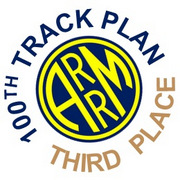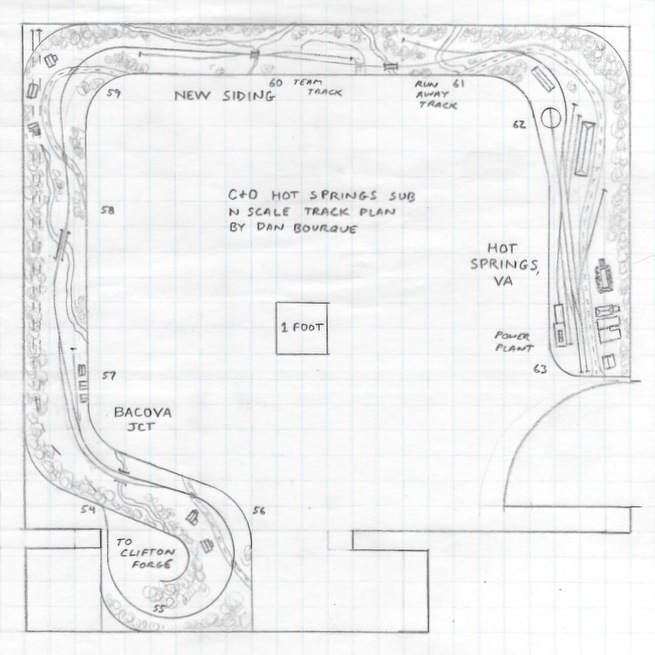- Size: 12′ x 12′
- Scale: N
- Minimum Radius: 15″
- Minimum Aisle Width: N/A
- Designed by Dan Bourque
 The Chesapeake and Ohio’s Hot Springs Sub ran 24 miles from a connection with the Alleghany Subdivision at Covington, VA. For most of its life, the line’s primary purpose was shuttling passengers back-and-forth to the resort town of Hot Springs, Virginia. While not a coal line, this line shares many of the features of more coal-heavy counterparts including steep grades and beautiful mountain scenery. As a bonus, the C&O hauled some coal up the line to serve the small power plant at Hot Springs.
The Chesapeake and Ohio’s Hot Springs Sub ran 24 miles from a connection with the Alleghany Subdivision at Covington, VA. For most of its life, the line’s primary purpose was shuttling passengers back-and-forth to the resort town of Hot Springs, Virginia. While not a coal line, this line shares many of the features of more coal-heavy counterparts including steep grades and beautiful mountain scenery. As a bonus, the C&O hauled some coal up the line to serve the small power plant at Hot Springs.
The Layout
This track plan represents the end of the Hot Springs Sub as it appeared for most of its life in both the steam and diesel era with a few sidings but mainly focused on the end of the line and Hot Springs. Included are the stations of Bacova Jct (formerly site of a junction with a lumber railroad), New Siding and Hot Springs. The layout is designed as a shelf railroad occupying the walls and 1/2 of the closet of a 10′ x 12′ bedroom. This design allows the room to also be used as an office or bedroom.
The track layouts are based on track charts from 1937 and aerial photos from 1958. All tracks are included, albeit in a shortened version, except for a crossover at Bacova and a redundant side track at Hot Springs. The distance between towns is compressed, but there is still enough scenery between towns to give the feeling of distance. Staging, representing Clifton Forge where the passenger trains originated, is a two-track affair tucked under Bacova Jct.
Construction of this layout would be straightforward with commercial switches and simple box benchwork. A DC control system with a single walk-around throttle would be more than adequate, though a smaller DCC system like an MRC Prodigy would also work fine. The centerpiece of Hot Springs is the giant Homestead Resort which sat just off layout beyond the end of the tracks at Hot Springs. An enterprising modeler could place a photo of the hotel on the back side of the door blended in with the backdrop to further capture the feel of the area.
Operations
This layout is designed for one, though an operating session could easily fill up an hour due to the number of moves required, especially at Hot Springs. In the later years, trains ran as mixed passenger/freights with a single locomotive (2-8-0 No. 701 or a GP7/9), 2-3 passenger cars (including occasional Pennsylvania Railroad Cars), a couple of freight cars including coal for the power plant, and a caboose. The train would leave Clifton Forge, traversing the C&O main to Covington, VA where it would travel the 24 miles of the branch. The passenger cars would surely be set off at Hot Springs before making any freight moves, including a run back down to New Siding or Bacova Jct. After the freight moves are complete, the crew would reassemble the train and likely return to Clifton Forge with the passenger cars at the appointed time, though the occasional special car might be left for the use of its lessors.
While passenger operations ruled this branch well beyond the decline of passenger operations on other branches, there was still a respectable amount of industry for the modeler. In addition to the facing point siding for the power plant, a 1950 C&O Industrial Directory lists 6 customers that used a 19-car Team Track at Hot Springs (could be the one in New Siding) including C&A Lumber Co, Highland County A.A.A. (fertilizer), E. E. Hinneman (lumber), Home Oil Co, C. N. Loving (coal yard), and Virginian Hot Springs, Inc (hostelry). The same directory does not list Bacova Jct., but the track charts label the spur as “industrial trackage” which might call for the occasional loaded boxcar or flatcar. Additional variety could be gained by running multiple eras with a steam-era layout having more passenger cars and perhaps a local freight instead of a mix.
Things I Like About this Plan:
- Relatively uncompressed
- Shelf design allows use of space for office or bedroom
- Mixed trains of varnish and coal
Things I Don’t Like About this Plan:
- Small in scope
- Few trains
- Repetitive operations
Related Products:






Railroad Model Craftsman had a nice article on this branch. but it was quite a few years ago. GP-7 #5890 was pictured doing the honors on that day.
I don’t remember the exact time frame but it was maybe the early 1970’s. It’s also mentioned, if not featured, in a softbound book about the C&O, maybe Thomas Dixon’s “C&O: Super Power to Diesels” but I’m not sure about that one, The photos showed GP-7 #5829, IIRC, powering the train that day.
I’m not too familiar with N-scale motive power but a steam-generator-equipped GP-7 would be right at home, working this line. I hope someone can build it and share the pictures with us someday.
the branch line ran along the Jackson River for its length, which was actually the defining feature of the Hot Springs Branch, so that should figure more prominently in the layout plan. For the most part the line was directly adjacent the river. One can cycle or hike half of the branch today, it’s a rail trail called the Jackson River Scenic Trail, though it does not reach Hot Springs.